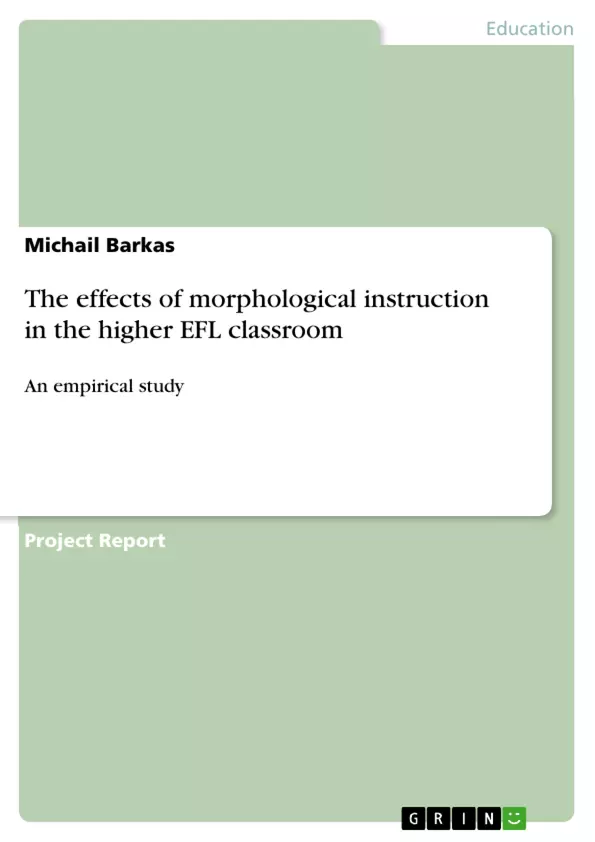The present study was realised during the first phase of teachers‘ vocational training in Germany and seeks to observe the effects of morphological instruction in a class of the qualification level. A diagnostic test that was carried out based on some spelling mistakes in writing tasks during the first month of the training, suggested that learners lacked knowledge in some basic spelling changes in the area of derivational morphology. Also, when they were asked to draw lines between morphemes in some words, in order to control to what extent they can identify word components the degree of uncertainty was high. Given the fact that no explicit instruction on morphology ever took place in the class, it was decided to observe whether learners of higher classes can benefit from a morphological instruction and what conclusions can be drawn from the results.
Inhaltsverzeichnis (Table of Contents)
- Introduction
- Interest in the current study
- Morphology in the curriculum
- Theoretical Framework
- The importance of morphological awareness
- Morphology and the mental lexicon
- Research Questions
- Methodology
- Participants
- The diagnostic test
- Introduced morphological aspects
- Procedure
- Results
- The diagnostic test
- The final test
- The questionnaire
- Conclusion
Zielsetzung und Themenschwerpunkte (Objectives and Key Themes)
This study investigates the effects of morphological instruction in a higher EFL classroom, focusing on the impact of morphological awareness on learners' spelling, vocabulary acquisition, and overall language proficiency. It aims to assess whether morphological instruction can be a valuable tool to enhance learner performance in the higher EFL classroom.
- The role of morphological awareness in language learning
- The effects of morphological instruction on spelling and vocabulary acquisition
- The impact of morphological awareness on learners' overall language proficiency
- The significance of morphology in the EFL curriculum
- The potential benefits and challenges of incorporating morphological instruction in the EFL classroom
Zusammenfassung der Kapitel (Chapter Summaries)
The introduction delves into the rationale behind the study, highlighting the lack of emphasis on morphology in the EFL curriculum and the potential benefits of morphological instruction for learners. It presents the context of the study, emphasizing the challenges faced by learners in the higher EFL classroom. The chapter on the theoretical framework explores the importance of morphological awareness in various aspects of language learning, including pronunciation, spelling, and vocabulary acquisition. It examines the representation of words and meanings in the mental lexicon, highlighting the role of morphology in processing and understanding words. The methodology chapter outlines the study's design, participants, instruments, and procedures. It details the diagnostic test used to assess learners' initial morphological knowledge, the specific morphological aspects introduced during the instruction, and the methods employed to collect and analyze data. The results section presents the findings of the study, analyzing the performance of learners on the diagnostic test, the final test, and the questionnaire. This section provides insights into the effectiveness of the morphological instruction and its impact on learners' performance. The conclusion chapter summarizes the key findings of the study, drawing conclusions about the effectiveness of morphological instruction in the higher EFL classroom.
Schlüsselwörter (Keywords)
The study focuses on the impact of morphological instruction on EFL learners in the higher classroom. Key themes include morphological awareness, vocabulary acquisition, spelling skills, language proficiency, and the EFL curriculum. The research utilizes an empirical approach to explore the effects of incorporating morphological instruction within the EFL classroom context.
- Citar trabajo
- Dipl. Archäologe / B. Ed. Englisch-Latein Michail Barkas (Autor), 2018, The effects of morphological instruction in the higher EFL classroom, Múnich, GRIN Verlag, https://www.grin.com/document/428227



